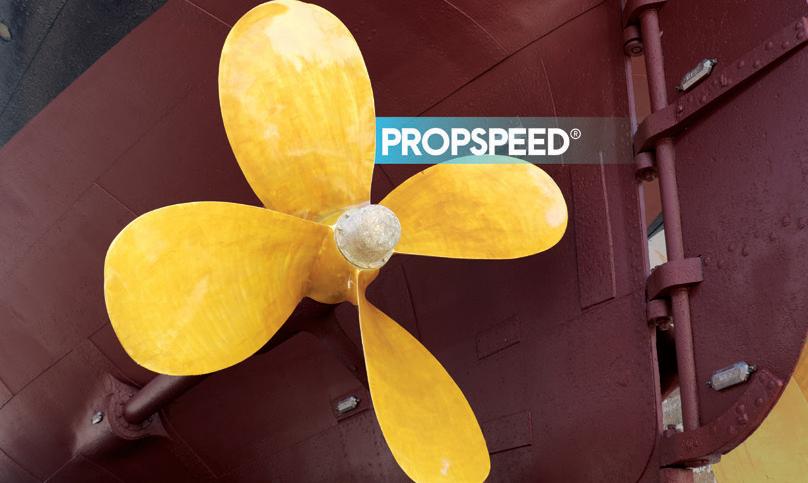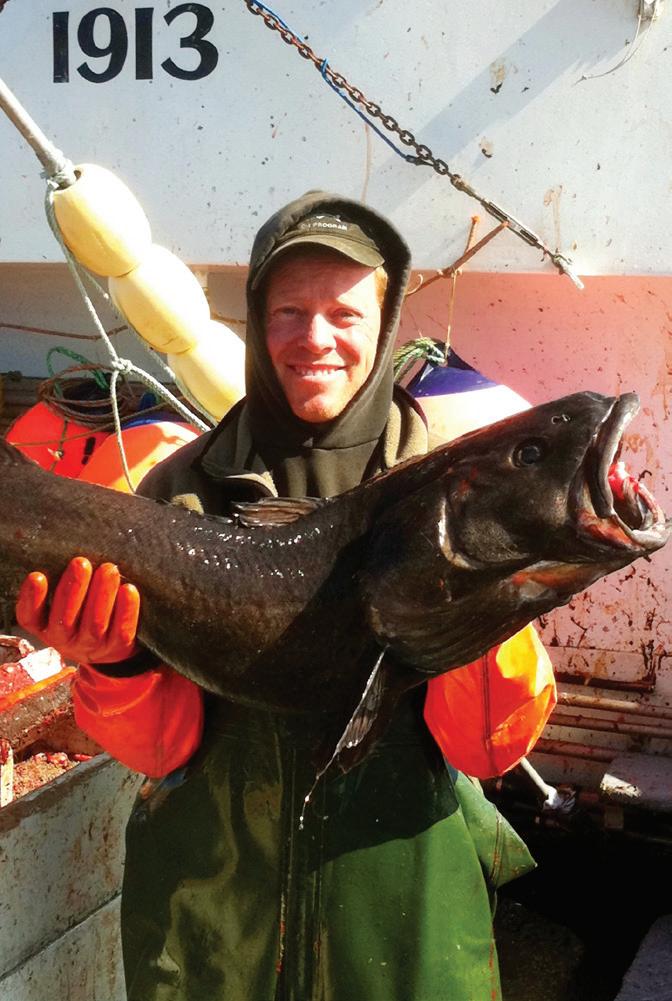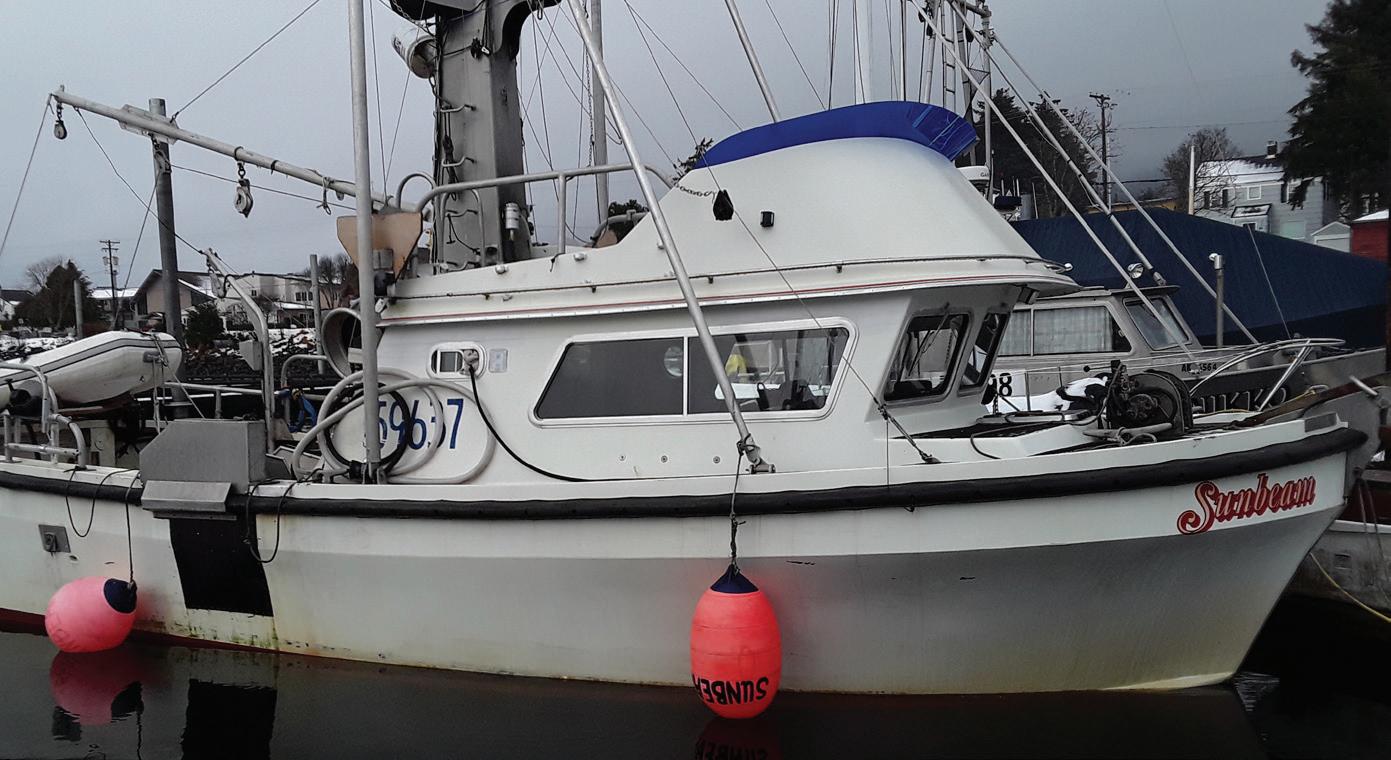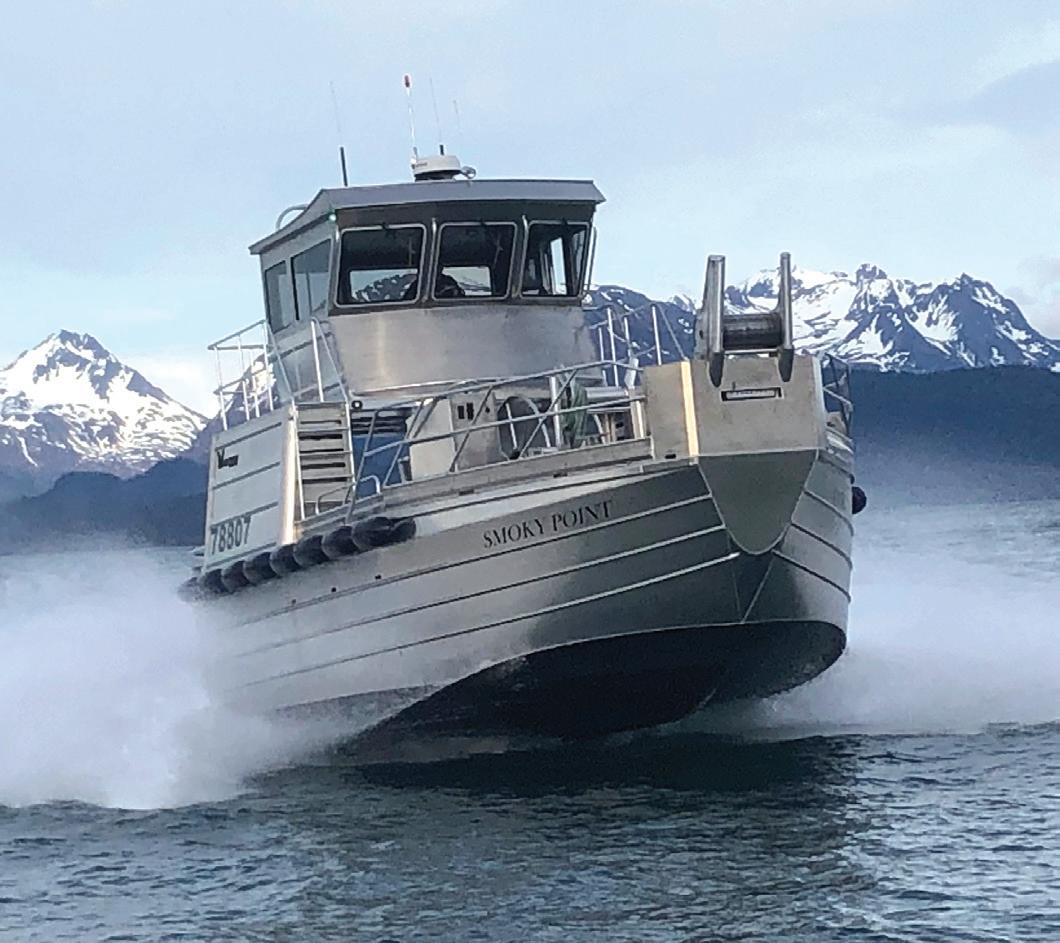
29 minute read
Offshore wind
POWER SURGE
With Vineyard Wind on approval track, 10 more reviews in the wings
By Kirk Moore
building wave for o shore wind
Aenergy surged out of the Biden administration, with March 29 announcements that set a goal of building 30,000 megawatts of capacity and opening up to 800,000 more acres for leasing in the New York Bight.
Two weeks later, the Bureau of Ocean Energy Management moderated the plan, withdrawing potential leasing areas o New York — acknowledging con icts with commercial shing, maritime tra c and tourism that will be rife in the East Coast’s most crowded waters.
But on a broad scale, it appears to be full speed ahead for BOEM. Even during the Trump administration’s tful approach to o shore wind, the agency itself worked consistently to make leasing possible for wind power developers.
Today there are 17 active leases, comprising 1.7 million acres, says BOEM Director Amanda Lefton. Ten more environmental reviews could be started this year, and construction and operation plans for 16 projects could be in place by 2025, Lefton said during an April 14 online meeting of BOEM’s New York Bight task force.
Now an “all of government approach” is being brought to bear, and the “New York Bight will play a central role” in reaching the administration’s 30,000-MW goal, said Lefton.
BOEM has “a steadfast commitment to do this right” by shermen and other stakeholders, and the New York Bight is a place where collaboration is working, she said.
But one prominent group not in virtual attendance that day was the Responsible O shore Development Alliance, a coalition of shing groups and communities. The group has been meeting for years with BOEM planners and wind developers, but in recent weeks reacted with alarm to the Biden administration’s full-court press to expand the industry.
“Fishermen have shown up for years to ‘engage’ in processes where spatial constraints and, often, the actors themselves are opposed to their livelihood,” according to a letter RODA submitted to the task force, stating it would boycott the meetings in protest.
“This time and e ort has resulted in e ectively no accommodations to mitigate impacts from individual developers or the supposedly unbiased federal and state governments,” the letter says. “Individuals from the shing community care deeply, but the deck is so stacked that they are exhausted and even traumatized by this relentless assault on their worth and expertise.” (Read the letter in our Mail Buoy section on page 4.) The Interior Department formally reversed a Trump-era legal opinion on o shore wind energy, with an April 9 memo by Robert Anderson, the department’s principle deputy solicitor. That opinion critiqued and reversed ndings written

in December by Daniel Jorjani, who was the department’s top lawyer when thenInterior Secretary David Bernhardt moved to shut down the approval process for the Vineyard Wind offshore project.
In that earlier 16-page document, Jorjani held that if Bernhardt “determines that either fishing or vessel transit constitute ‘reasonable uses… of the exclusive economic zone, the high seas and the territorial sea,’ the Secretary has a duty to prevent interference with that use.”
Moreover, Jorjani wrote, the Interior secretary should determine “what is unreasonable” interference from offshore wind turbines “based on the perspective of the fishing user.” That was a victory for commercial fishing advocates who had gone directly to Bernhardt with their concerns.
In the new memo — five pages dense with analysis of the Outer Continental Shelf Lands Act and related court decisions — Anderson wrote that the act requires the Interior secretary to consider a dozen specific goals of the law when making decisions. Those factors could favor “actions to maximize low-emission and renewable electrical generation from offshore wind facilities,” Anderson wrote.
The bureaucratic memo further paved the way for a BOEM record of decision to approve the 800-megawatt Vineyard Wind project off southern New England, where RODA and other fishing industry advocates have pushed the developers and BOEM to include mitigation measures.
Fishermen sought 4-nautical-milewide transit lanes to ensure safe passage through wind energy areas in heavy weather. Developers and Coast Guard officials said 1-nm spacing between turbine towers on lease areas will be adequate. The final record of decision would include a ruling on that.
“Technically, we don’t know,” said Annie Hawkins, executive director of the Responsible Offshore Development Alliance, while awaiting that decision. “They could address some of these fisheries issues (in the decision). It doesn’t look promising.”
Commercial fishing groups that at best have had a rocky relationship with
BOEM and wind developers were shaken by the breadth of the administration’s goals. Hawkins said there was no sign of new commitment to head off potential conflicts between the industries.
“These fisheries questions have been around for a decade,” said Hawkins. “We don’t have an interagency process” for understanding and resolving them, she added: “We’re just blown away by the lack of coordination.”
Ringing White House endorsements of wind power call into question how

Maine fishermen demonstrated against plans for a research wind turbine in state waters.
— Annie Hawkins, RESPONSIBLE OFFSHORE DEVELOPMENT ALLIANCE federal agencies will handle reviews under the National Environmental Policy Act and other regulatory measures, said Hawkins.
“Can you imagine if this assessment was for oil and gas (development)? How would that look?” she said. “This whole thing is so upside-down. It’s not like the way we regulate any other resource.”
While RODA sat out the New York Bight meetings, NMFS was represented. The agency did not hold back on its view of potential environmental and fisheries impact should more wind energy areas be developed in the New York Bight.
The region “is one of the most important areas on the East Coast for commercial and recreational fisheries,” said Sue Tuxbury, a fisheries biologist in the agency’s habitat conservation division who works on wind energy and hydropower activities.
Surf clams and scallops, two of the most valuable East Coast fisheries, have major shellfish resources on the bottom. “The location and number of turbines” will be a major factor in whether those dredge fisheries can continue to operate around the wind areas, said Tuxbury.
She recommended that BOEM and the bight task force consult RODA’s 2019 workshop on fishing vessel transit issues — and for the agency to hold new meetings with commercial fishermen to

The Bureau of Ocean Energy Management has 17 active wind leases comprising 1.7 million acres, according to Director Amanda Lefton.
discuss potential tra c lanes for New Jersey ports Barnegat Light and Cape May, close to the planned Ocean Wind and Atlantic Shores turbine arrays.
Tuxbury said unknown environmental questions include how those arrays may a ect the Mid-Atlantic cold pool, the seasonal strati cation of water temperatures that is in uential on the life cycles of sh and other marine life. New surveys and scienti c modeling are needed to anticipate how those changes may happen and play out, she said.
BOEM’s proposed wind energy areas include essential sh habitat “for nearly every species” managed by NMFS and the New England and MidAtlantic shery management councils, said Tuxbury. Building turbines out there “will directly impact” the agency’s ability to conduct at-sea scienti c surveys that managers depend on to make decisions, she said.
Survey vessels operated by NOAA will likely be excluded from operating their trawl sampling gear in wind energy areas by spatial constraints between turbine towers. Along with the need for longer vessel transit times to get around arrays, that will reduce biological sampling, said Tuxbury.
Fishing con icts were one reason BOEM planners cited in dropping two areas near Long Island from immediate consideration for o shore wind energy leases.
The Fairways North and South areas, named for nearby shipping approaches to New York Harbor, have scallop and surf clam beds, issues with maritime tra c and whale feeding areas, and the potential for raising the ire of beachfront homeowners and tourism businesses on Long Island’s South Shore.
New York state o cials recommended against planning for leases in the Fairway areas, saying the closest 15-mile proximity to Long Island runs counter to the state’s policy of keeping wind generation at least 18 miles from shore.
With o shore wind development gaining momentum, resistance could build on other residential shorelines. That was evident as BOEM initiated its environmental review process for the Ocean Wind project, Ørsted’s planned 1,100-MW array o Atlantic City.
“We’re very concerned about the impact on tourism,” said Beach Haven, N.J., Mayor Colleen Lambert during BOEM’s April 15 online scoping meeting on Ocean Wind.
The Ocean Wind tract at its closest is 15 miles o shore, and turbine blades could be visible from shore on some days, according to BOEM visual simulations.
BOEM has been gauging potential developer interest in areas farther o shore, and the task force is part of its environmental assessment of those areas.
Those developments could be slowed by a shortage of wind turbine installation vessels with more projects planned in Europe and Asia. In U.S. waters, developers will need to abide by the Jones Act — the 1920 federal



877-682-8354 (506) 727-5039
www.ovatek.com “No Service” Liferafts



The ONLY rigid life rafts in the world. Puncture proof, self-righting, unsinkable, watertight, and more. Save $600 to $1,700 annually by . Puncture proof, self-righting, unsinkable, watertight, and more. Save $600 to $1,700 annually by not having to return/inspect it. Unlimited shelf-life with a dual fiberglass sandwich hull. USCG, Transport Canada and SOLAS approved.













maritime law that requires using U.S. agged vessels and crews.
Vineyard Wind’s plan is to use Belgium-based DEME O shore’s installation vessels, teamed with U.S. ag vessels of Foss Maritime, using the “feeder” concept of a foreign- ag wind turbine installation vessel supplied onsite by Jones Act-compliant U.S. vessels.
Virginia-based Dominion Energy is backing construction of its own 472-foot U.S.- agged installation vessel, amid widespread concern in the industry that global demand for services of those heavy-lift vessels could slow the development of projects in U.S. waters.
All that action now is focused on the shallow outer continental shelf from Cape Cod to the Carolinas. But wind developers are already looking ahead to oat anchored wind turbines in deep water like the Gulf of Maine.
“We’re trying to keep Maine waters free from this industrialization,” said Dustin Delano, a Friendship, Maine, lobsterman who helped organize a March 21 demonstration by shermen with more than 80 boats on the water protesting plans for o shore wind.
“This would ll the ocean with anchors, cables and chains,” said Delano. “Maine is unique in the nation. Our entire heritage is shing and tourism.”
The Maine Aqua Ventus project would be a 12-MW oating turbine to test the feasibility of commercial-scale wind power arrays in the deepwater Gulf of Maine.
With the Biden administration promising $3 billion in loan guarantees to jump-start o shore turbine construction, a new Sea Grant program to study impacts on shing seems a pittance to the shing industry. “That $1 million program for Sea Grant to nd impacts of development on shing communities “won’t understand the impact in one Maine lobster village,” said Hawkins.
DEME Offshore

Vineyard Wind will use Belgium’s DEME Offshore to install its wind turbines, supplied by the U.S.- agged Foss Maritime eet.
Kirk Moore is the associate editor for National Fisherman.

Durability, Dependability & Quality For Over 35 Years KINEMATICS Marine Equipment, Inc.
BRISTOL BAY ROLLERS
POWER BLOCK CUSTOM GILLNET & LONGLINE DRUMS
TWISTER WHEEL DRIVE TWISTER PLANETARY DRUM DRIVE
ANCHOR WINCH
For Our Complete Line of Deck Gear go to www.kinematicsmarine.com
5625 48th Dr. N.E. Unit B Marysville, WA 98270 Phone: (360) 659-5415 • Fax: (360) 653-5151
OFF THE HOOK

Slinky pots revolutionize Alaska’s blackcod fishery
By Brian Hagenbuch
hen Shawn McManus, skipper of the F/V
WVansee, left Seattle in the spring of 2020 to longline for blackcod in Alaska, the outlook was not good. The burgeoning pandemic had injected uncertainty into a fishery that was already struggling with flagging prices and crippling whale depredation.
On the grounds, McManus and his colleagues estimated half their catch, sometimes more, was being snatched off hooks by orcas and sperm whales. Fishermen with bigger boats and more powerful hydraulics had long ago switched to whale-proof rigid pots, but they were not an option for smaller operations like the Vansee, a 107-year-old halibut schooner with limited deck space.
Veteran fisherman Buck Laukitis was among those who had switched to rigid pots. He looked on in dismay as depredation threatened not just individual boats but the fishery at large.
“We needed 75 or 80 percent of the fishing done by pots, or we were going to kill the resource off by feeding whales,” Laukitis said.
In a last ditch attempt to save his season, McManus threw in 50 so-called slinky pots before he left Seattle’s Fishermen’s Terminal. To him, it was a new and virtually unknown product, a lightweight collapsible pot that would fold flat and stack on deck, giving boats like his a chance to get off hooks and into pots.
“After just trying a couple days, the writing was on the wall. We knew the only way we were going to catch all of our fish was to purchase more of these pots. We fully converted over. They’ve been a lifesaver for us, and really the entire fishery,” McManus said.
The pots had made their Alaska debut just a few months
The crew of the F/V Vansee (above) preps new CodCoil, or slinky, pots. The gear is made for longliners tired of feeding whales a seafood buffet and is noted for being collapsible and lightweight.
— Buck Laukitis, F/V ORACLE
Pete Sawle runs Fish Tech in Oregon and had 60 pots sent to Kodiak, Alaska. Here he outfits the F/V Rocky B, one of 50 boats he rigged.

earlier in the fall of 2019 when skipper Pete Sawle saw a short video posted online by California fisherman and biologist Alexander Stubbs, who invented the slinky pot with his business partner Adam Sewall.
— Buck Laukitis, F/V ORACLE
Sawle had 60 of the pots, dubbed CodCoil by Stubbs, shipped to Kodiak, Alaska, found they worked very well, and partnered with Stubbs and Sewall’s business Longline Pots to sell them last winter. Sawle — who runs Fish Tech out of Oregon — estimates the group has outfitted around 50 boats with the slinky pots

The crew of the F/V Devotion easily handles a lightweight CodCoil pot with live catch.
Courtesy Ryan Johnson

Captain Shawn McManus proudly holds a pot-caught blackcod on the F/V Vansee.
while inspiring other fishermen to send their own manufacturing to China to make knock-offs.
It all amounts to a gear shift fishermen say is unprecedented.
“In my 40 years of fishing in Alaska, I’ve never seen a transformation like in the last year since these slinkies came online,” Laukitis said. “It was almost like what the tech industry does. The

The standard CodCoil is made with 6-mm hot dip galvanized steel, has a 27-inch hoop and is about 50 inches long. It weighs less than 10 pounds and can be collapsed on deck.
change was so rapid and so profound. You’ve got guys who have never changed anything ever, and all of a sudden, they’re using this new gear. It’s
CodCoil vs. Longline
▪ Clips directly to existing long line groundline, making for an easy conversion. ▪ Reduces bait expenses. ▪ Easy for as few as two people to run, stack and reset. ▪ Minimizes loss to whales. the biggest thing I’ve ever seen.”
And according to McManus, the collapsible pots’ opportune arrival and rapid spread is keeping people in the blackcod business.
“I think without these slinky pots, you would have had people going out of business or selling out,” McManus said.
Part of the slinky pot’s success stems from its a ordability. The pots run around $75 to $150, but shermen can use the same ground line they use for hooks and do not need expensive new haulers or hydraulics.
The lightweight slinky pots — they range from around 10 to 16 pounds — are also easier to sh in heavy weather or with reduced crews, perfect for a shery with atrophied margins.
CodCoil vs. Rigid Pots
▪ Light, collapsible design lets you fi sh at least three times the pots. ▪ Enables pot fi shing on boats as small as 25 feet. ▪ Easy substitution for any type of snap on or C-link gear. ▪ Pots stack effi ciently on almost any size boat. ▪ Less than 10 pounds each for easy handling. ▪ Pots partially collapse while being hauled, reducing drag and increasing the number of pots that can be fi shed on a string. ▪ Lower return on investment with less expensive design. ▪ Knotless web does not damage fi sh, making it a good fi t for fresh and live markets. ▪ Run gear with a standard Dungeness crab block and 3/8" or 5/16" line. ▪ Easy to stack hundreds of pots when going back to port for delivery.
Continued on page 41
EVK WATER LUBRICATED SHAFT SEAL EVK STYLE RUDDER SEAL SPLIT OR SOLID DESIGN ST-100 WATER SOLUBLE NON-SHEENING EAL OIL LUBRICATED SEALS FOR THRUSTERS AND STERN TUBES

ST-100
FACTORY DIRECT SALES & SERVICE
KEMEL USA is the marine division of EKK EAGLE AMERICA INC. 31555 West 14 Mile Rd, Suite 200 | Farmington Hills, MI 48334 CONTACT US
SALES@KEMELUSA.COM | KEMELUSA.COM GENERAL INQUIRES: 408-398-3383 *ANYTIME* TECHNICAL SUPPORT: 212-967-5575


Riding
THE WAVE


By Paul Molyneaux
Boatbuilders, designers and fi shermen take advantage of new technology and design for the times
ne indicator of the O health of a shery is the number of new boats being built for it, and design trends of those boats add more to the story. North Paci c sheries journalist and author Peter Marsh estimates that between West Coast and Alaska boatbuilders, somewhere close to 30 new gillnetters will enter the healthy Bristol Bay salmon shery in 2021.
“And this is a slow year, due to the pandemic,” he says.
Tom Farrell, of Farrell and Norton Naval Architects in Maine, is busy designing scallopers for the lucrative Atlantic scallop shery. A number of his and his partner Garrett Norton’s boats have arrived in New Bedford in recent years, and more are coming.
For decades, the lobster industry has sustained shing communities on the coast of Maine, and Moses Ortiz, owner of Boricua Custom boats in Harrington, Maine, has tted out numerous hulls for that shery. But as climate change and markets create uncertainty

Boricua Custom boats is building the 44-foot Grin-N-Barrett as a combination lobster boat and scallop dragger.


for lobsters, sherman Dean Barrett is having Ortiz build a boat for lobstering and scalloping.
“Dean is a really hard-working sherman,” says Ortiz. “He lobsters, and then goes scalloping down in Massachusetts.” Ortiz is tting out Barrett’s boat to make it more e cient in both sheries. “This boat is one of a kind. It started as a 47foot Osmond [Beal]. H&H chopped it down to 44, and I made it 48.” According to Ortiz, the boat’s 1,000-hp MAN engine had the wrong gear. “It was 1.9, supposed to be 2.2.” Ortiz has strengthened the boat for mounting an A-frame and winch.
“We’re ready to mount the winch,” says Ortiz. “It’s pretty much a plug and play system. It came from Billings in Stonington. Lonnie’s Hydraulic set up the hydraulics system.”
The Atlantic scallop shery is a lifeline for small boats looking to diversify, and 200-pound-per-day permits for the northern Gulf of Maine are selling for upward of $80,000. Newbuilds for the general category eet, primarily out of New Bedford, have led to many innovations. One of the most interesting is the use of wing stabilizers, as seen in the NF May ’21 story on the F/V Heritage.
“They’re very popular. We’re putting them on a few boats in the scallop

Marinexpert Plus in Gaspe, Quebec has sold more than 500 wing stabilizer kits, including for the Boston-based longliner Iron Maiden (above) and the New Bedford scalloper Heritage (right).
shery, and we put them on a clam boat in New Jersey, the Christi Caroline,” says Farrell.
Dorchester Shipyard in New Jersey added the stabilizers to the 55-year-old Christi Caroline, which was rebuilt in 2017-18 at Boconco in Bayou La Batre, Ala., returning to service after a 13-year hiatus.
“What happened was she caught re and made it back to port on December 2, 2005,” says Tom Dameron, sheries liaison for the vessel owner Surfside Foods. “We basically took her down to the keel and built a new boat on top of her.” The new Christi Caroline, 124.5 feet long, 32 feet wide, with an 11-foot draft, is built on a mere 8 feet, 9 inches of the original. She made her rst clamming trip in September Duckworth Boats 2018, and the wing stabilizers were added in 2019. “We saw some done at Fairhaven Shipyard and thought we would give them a try,” says Dameron. “From what I hear, the guys really like them.”
Stephane Loubert, owner of Marinexpert Plus in Gaspe, Quebec, has

WESTEC CAN SUPPLY YOU!
Manufacturer of: Bowthrusters ∙ Power Blocks Fish Pumps & Fish Pumping Systems Hydraulic Pump Drives and Pursing Winches

We can also custom design and manufacture a wide variety of machinery, including: Fishing Winches, Specialty Purpose Winches and other Net Handling Equipment and Deck Machinery all carefully tailored to meet your specific requirements.


1514 Bay St. North Vancouver ∙ British Columbia, Canada V7J 1A1 Tel: (604) 988-1130 ∙ Fax: (604) 988-1173 info@westecequipment.com ∙ www.westecequipment.com 32’ x 17’ Bristol Bay Boat

High Standards and Cutting Edge Technology
Construction of fishing boats has been a specialty at Rozema Boat Works for more than 60 years. Building safe and reliable vessels to meet our customers’ exact specifications is our top priority. Today our fishing boats are working up and down the west coast of the United States and throughout Alaska.
Contact us Today!
11130 Bayview-Edison Rd. Mount Vernon, WA 98273 P: (360) 757-6004 F: (360) 757-6005

designed most of the wing stabilizers for Farrell and other naval architects.
“I did my rst one for the Fundy Leader, which was launched in 2006. Since then, I’ve done around 500. About 95 percent of the boats around here have switched from paravanes to wings. If they’re forward on the hull, they can help control the pitch, too.” Loubert has designed wings for 15 boats in the United States, so far. “The rst one was the Iron Maiden, in Boston,” says Loubert. “Sometimes we send the les to the yards, but on six or seven, we put them together here and sent them.”
With the wings folded up in port, Loubert notes that they have to be protected. “We fabricate protectors, steel triangles that stick out from the hull on each side of the wing, or you can use those big balls. If you’re building new, you can add a place for them to t into the hull when they are up.”
Among the advantages of the wing stabilizers that Loubert touts is fuel savings. “Our customers tell us that they lose half a knot with the wings down. They say with paravanes, they lose a knot.”
Farrell agrees that while healthy sheries lead to new boats being built, so does an aging eet. “We’re also working on a couple of draggers, because at a certain point you have to replace these boats.”
While hybrid power is another innovation getting attention from shermen and architects, so far, the boats Farrell is designing are all diesel. “It’s coming, though,” he says. “Electric systems used to be too expensive, but now the price is getting so it is becoming a viable option.”
On the West Coast, the 184-foot longliner Northern Leader splashed in 2013 with a hybrid Z-drive system.
“They saved $500,000 in fuel the rst year. So their payback for going diesel-electric was four to ve years,” says Jonathan Parrott, of Jensen Maritime, designers of the vessel. “If they had batteries, the capital costs would be higher, but the savings would be even greater.” Since then, however, no other new big boats have gone hybrid. Parrott reports


The 184-foot factory longline vessel Northern Leader combines diesel electric power and a low-impact fi shing method to land quality product with a lower carbon footprint.


zfmarinepropulsion.com // 833-939-7362

By improvising his own hybrid power system for his 34-foot gillnetter longliner, the Sunbeam, Fabian Grutter believes he can get up to 80 percent fuel savings when fishing close to home.
no new orders for hybrid powered commercial fishing vessels.
“Most of the action is in tugs. We are currently working on a fully electric tug for SoCal, it has generators aboard, but only for long-distance travel. The batteries will supply power for day-today work, for the most part. There is talk of fuel cells, but that entails some type of fuel — either hydrogen, LNG, methanol or ammonia, or something similar.”
Big boats may not be opting for hybrid systems, but there is some action in the small boat fleet. Contrasting with the sophistication of the engineering that went into the Northern Leader, Fabian Grutter of Sitka, Alaska, combined an improvised electric power system with

With 10 70-kW batteries from China, Grutter’s costs are lower than a turnkey system.


the 350-hp John Deere on his 34-foot boat, the Sunbeam. “I melted the batteries,” says Grutter of his initial e orts, but he persisted. “I bought another 10 70-kilowatt batteries that I had made in China,” he says. “And a new BMS [battery management system]. It’s all working now. It saves me about 15 percent when I go out on long trips for halibut and blackcod, about 80 percent when I’m gillnetting close to home.”
Grutter’s idea has caught on with other small-boat owners. Eric Jordan and Kent Barkhau of the Alaska Longline Fishermen’s Association are reportedly preparing to go hybrid.
“They’re committed,” says Chandler Kemp, owner of Kempy Electronics in Sitka. “We’re applying for grants to help fund switching to hybrid systems.” According to Kemp, the shermen are in talks with the Italian company Trans uid for purchasing turnkey systems.
“Trans uid has a unit that goes between the engine and the gear,” says Kemp. “It allows you to switch from diesel to electric, and allows the engine to charge the batteries and the electric motor to help the engine.”
With batteries and motor included, the Trans uid system costs as much as $150,000, Kemp notes, and he is not sure about the payback. “I don’t think you can pay it back on fuel savings alone,” he says. “Maybe if you include reduced maintenance and longer engine life. But there’s pay-o s in noise reduction.”
Fabian Grutter’s 4-year-old son agrees. “When I have him on the boat and start up the diesel, he covers his ears and tells me to turn on the little motor.”
In Alaska’s Bristol Bay, many shermen are moving in the other direction, and are breaking the 1,000-hp barrier with twin installs of bigger engines. According to Mike Fourtner, commercial sales manager at Cummins, the company is putting twin 600-hp Cummins QSC 8.3 liter engines in dozens of Bristol Bay boats.


Peregrine Boats launched the Smoky Point with twin Cummins QSC 8.3-liter engines that get her up to speeds over 40 knots.
Maritime Fab Big Bay Roller
Stern Roller Strength Like You’ve Never Seen Before!
16” dia. Core for increased net traction & reduced fish knock-outs Heavy-duty 3/8” formed aluminum side frames
Integral ball valve for hubless freewheeling
Low profile base hinges with easily accessible locks
La Conner, WA: (360) 466-3629 www.laconnermaritime.com
91’ X 41.5’ TRAWLER
9,300 CF RSW HOLD CAPACITY
UNDER 79’ REGISTER LENGTH TO AVOID LOAD LINE
DESIGNED FOR EQUIVALENT TO CLASS PER 46 USC 4503(E) TWIN SCREW WITH EPA TIER 3 MAIN ENGINES OR SINGLE SCREW WITH EPA TIER 4 MAIN ENGINE
Seattle WA & Bend OR • Hockema.com 206.365.0919 • Marketing@Hockema.com

With boats getting wider and heavier, Cummins is selling twin engine packages — the QSC 8.3-liter, times two, delivers 1,200 hp.
“The boats are limited to 32 feet,” says Fourtner. “But they’ve gotten wider, a lot of them are now 17 feet, and that has increased the weight from around 20,000 pounds to 30,000. So they need the power.” That power is now available in smaller footprint engines, Fourtner points out, and it’s making boats much faster. “In the old days, if you went 12 knots, that was normal,” he says. “Now our boats are going over 40 knots. If you are faster than the other guy it could be the di erence between a $20,000 day and a $4,000 day.”
Dirk Rozema, owner of Rozema Boatworks in Mount Vernon, Wash., has built two 17-foot-wide Bristol Bay through-pickers for the 2021 season, both equipped with twin 600-hp Cummins engines, ZF gears and UltraJet 340 jets.
“The goal is to get up to speed and plane with 10,000 pounds of sh aboard,” says Rozema. “They deliver great performance for that area. If you need to get somewhere, you have the power you need.”
Looking after the needs of shermen, North American boatbuilders, engineers and designers continue to up the game in every aspect of boatbuilding, from safety to e ciency to productivity.
Paul Molyneaux is the Boats & Gear editor for National Fisherman and author of “The Doryman’s Re ection.”
Cast off to sea with the new DUNLOP SEAPRO
For generations, Dunlop Boots has been making the world’s most innovative and reliable work boot for the toughest jobs and harshest environments.
So when it came time to create a work boot to conquer the seas, we did what we always do:
WE GOT TO WORK.
We began by talking about boots with commercial fisherman all around the globe in any port they call home. Next, this boot had to be pushed to the same limits that every fisherman endures each time they push out to sea.
For that, we created Dunlop’s Slips, Trips and Fall Innovation Center. We wanted to test this boot on every surface they are going to stand on, from the freezing cold of Alaska to the scorching temperatures of Gulf of Mexico. Then we paired Dunlop’s proprietary lightweight and durable Purofort material with our innovative Snug-fit construction to eliminate heel slippage, resulting in a sneaker-like fit.
And the results?
This testing combined with Dunlop’s innovative materials creates the most comfortable and hardest working fishing boot ever: the Dunlop SeaPRO.
PRODUCT CONTACT
Phone: +1 410 272 2000 Fax: +1 410 272 3346 Website: www.dunlopboots.com
FOR MORE INFORMATION: https://www.dunlopboots.com/
PRODUCT ANNOUNCEMENT









